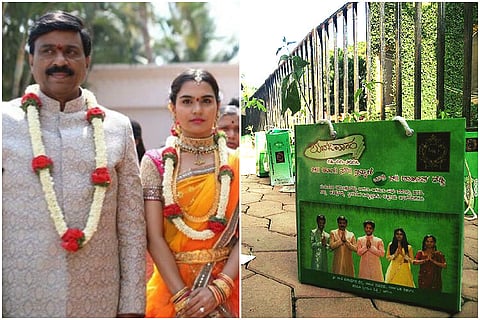

For all the opulence and extravagance that marked the five-day wedding of mining baron and former BJP minister Janardhana Reddy’s daughter, the return gift seemed like a private joke for the Reddy Brothers and their BFF, B Sriramulu.
On Wednesday afternoon, guests trickled out of the sprawling Palace Grounds in Bengaluru carrying green paper bags. A closer look revealed that two saplings peeped out of the top of the bags. On one side of the recyclable, a badly photoshopped image of the beaming Janardhana Reddy family thanked guest for accepting their hospitality. On the other side, it was Janardhana’s business partner and close aide, BJP MLA Sriramalu repeating the same message.
You have to give the hosts credit for being thorough. The paper page also contained a little card, informing the guests which species the saplings were: Sandalwood and tulsi, along with instructions on the care required to plant each sapling and how to look after it.
The return gift, was perhaps, Reddy’s idea of penance (Sarcasm implied). It was, after all, rather ironic that the man accused of plundering natural resources and doing irreparable damage to the environment chose to give away saplings.
An employee of Door Plants, which supplied the saplings, told The News Minute that over 50,000 saplings were distributed by Wednesday evening.
The big fat Reddy wedding has been in the headlines over the obscene display of wealth when thousands of Indians are standing in queue outside banks across the country, struggling to get their Rs 500 and Rs 1000 notes exchanged.
Reddy, who was in jail for three years for illegal mining cases, was released on bail in January 2015. An earlier bail had been cancelled as Reddy unscrupulously bribed a judge.
Notwithstanding the many violations that took place during the mining of iron-ore in Ballari and Anantapur districts, Reddy’s companies and others left behind a trail of environmental destruction.
Ballari, which was once known for its green cover and wildlife turned into red dust. In the 2000s, Ballari’s forest cover was drastically depleted as hills were blasted and flattened, and the district stripped of its wealth of natural resources.
Ending many years of indiscriminate mining, the Supreme Court in 2011 said that environment comes first, profits later.
Giving its verdict on a PIL filed by Samaja Parivarthana Samudaya, a Karnataka NGO, the court stopped 148 companies from mining in Ballari.
The biggest among these was the Obalapuram Mining Company, belonging to the Reddy brothers. OMC had allegedly encroached upon reserve forest areas in Andhra Pradesh.
In its 2011 order, Chief Justice of India SH Kapadia stated, “We are satisfied that, on account of over-exploitation, considerable damage has been done to the environment. We are taking a holistic view of the matter. We have suspended these operations keeping in mind the precautionary principle, which is the essence of Article 21 (Right to Life) of the Constitution.”
The consequences of the mining industry in Ballari have been felt on agriculture too, as once-fertile lands turned red with iron-ore silt and borewells dried up across the region.
Karnataka’s Water Resources Department revealed in 2013 that the area under irrigation in Ballari decreased from 2,324.80 hectares in 2001-02 to 2,192.51 hectares in 2010-11 because of mining.
Karnataka's mining boom that started in the late 1990s was centred in Ballari district, which was said to have reserves of about 1,000 million tonnes of iron ore.
Between 2001-2003 iron-ore production from the Ballari region was more than 13.9 million tonnes, just about 1.2 per cent of the total reserves.
According to the 2012 Lokayukta report on illegal mining, between 2000-01 and 2005-06, the production of iron ore increased from 12.09 million tonnes to 184.05 million tonnes.
Various reports by then Lokayukta N Santosh Hegde and officer UV Singh pointed out that 4000 to 5000 over loaded vehicles would ply on the roads everyday destroying connectivity.
Even a Medicinal Plant Conservation Area (MPCA) was not spared by the miners, noted Lokayukta officer UV Singh in his report.
UV Singh said, "Because of bad air quality the disease related to respiration has increased and skin diseases are at large. Dust clouds cover the forest tree species, agriculture crops fully. Due to dust fall the colour of the trees looks reddish-brown instead green even in the rainy season. 16 species of mammals, 145 species of birds, 9 species of reptiles are on the run."
A report by Centre for Science and Environment found, "Large expanses of barren land and open, watery pits. Dust-laden, sooty air, Grim-faced and grimy workers. Busy lines of trucks, bulldozers, excavators… usually, the abiding image of mining is one of monochromatic aridity and industry – indicative of what mining does to the landscape. But under this image and extending from it lie hundreds of other stories of how mining affects us: stories of human tragedy, environmental disaster and policy failures.'
A fact-finding report by Sakshi Trust said that ground water levels and increase in air pollution had affected the farmers.
Sakshi Trust also claimed that the incidence of cancer among people and respiratory problems in children had increased in those five years.